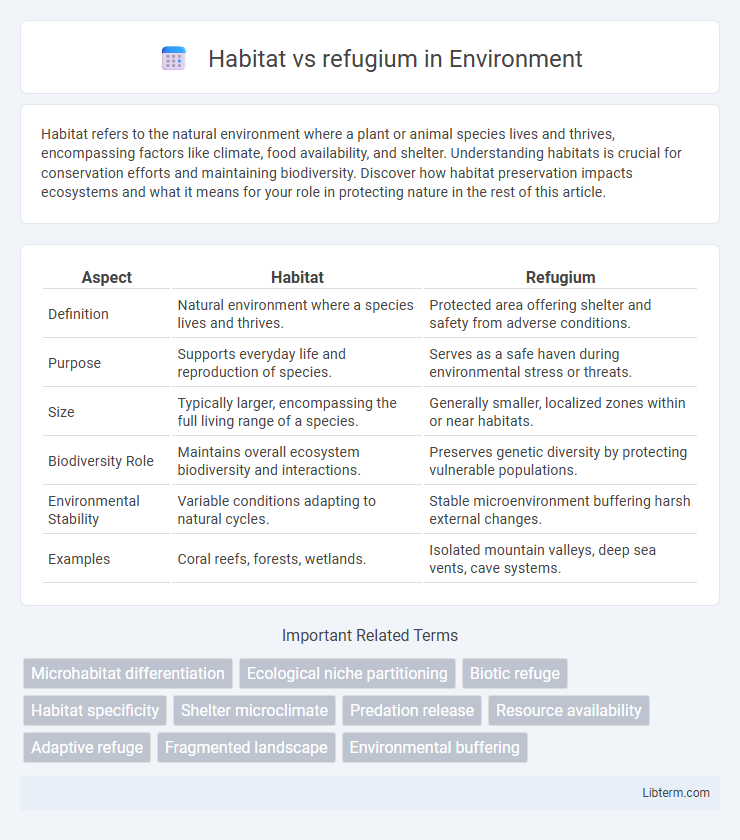Habitat refers to the natural environment where a plant or animal species lives and thrives, encompassing factors like climate, food availability, and shelter. Understanding habitats is crucial for conservation efforts and maintaining biodiversity. Discover how habitat preservation impacts ecosystems and what it means for your role in protecting nature in the rest of this article.
Table of Comparison
| Aspect | Habitat | Refugium |
|---|---|---|
| Definition | Natural environment where a species lives and thrives. | Protected area offering shelter and safety from adverse conditions. |
| Purpose | Supports everyday life and reproduction of species. | Serves as a safe haven during environmental stress or threats. |
| Size | Typically larger, encompassing the full living range of a species. | Generally smaller, localized zones within or near habitats. |
| Biodiversity Role | Maintains overall ecosystem biodiversity and interactions. | Preserves genetic diversity by protecting vulnerable populations. |
| Environmental Stability | Variable conditions adapting to natural cycles. | Stable microenvironment buffering harsh external changes. |
| Examples | Coral reefs, forests, wetlands. | Isolated mountain valleys, deep sea vents, cave systems. |
Introduction: Defining Habitat and Refugium
A habitat refers to the natural environment where a species lives, grows, and reproduces, encompassing factors like climate, food sources, and shelter. A refugium is a specific type of habitat that provides safe conditions for species to survive during adverse environmental changes, such as ice ages or habitat destruction. Understanding the distinction between habitat and refugium is crucial for conservation biology and species resilience studies.
Key Differences Between Habitat and Refugium
A habitat is the natural environment where a species lives, grows, and reproduces, providing essential resources like food, shelter, and mates. A refugium, however, is a smaller, protected area within or separate from a habitat, offering safe conditions during unfavorable environmental changes or disturbances. The key difference lies in scale and function: habitats support the full lifecycle of species, while refugia serve as temporary sanctuaries that preserve biodiversity during adverse periods.
Ecological Roles of Habitats
Habitats serve as the primary environment where organisms live, reproduce, and interact, supporting biodiversity by providing essential resources such as food, shelter, and breeding grounds. Refugia act as specialized habitats offering safe havens for species during adverse conditions like climate change or habitat destruction, enabling survival and genetic diversity preservation. The ecological role of habitats encompasses maintaining ecosystem stability, while refugia contribute to resilience by safeguarding vulnerable populations and promoting species recovery.
The Function of Refugia in Nature
Refugia serve as essential safe zones that protect species from adverse environmental changes and facilitate biodiversity persistence during periods of climate fluctuation. These areas act as natural sanctuaries by offering stable microclimates and resources, enabling species survival and genetic diversity conservation. Habitat, in contrast, is the broader natural environment where a species normally lives and interacts with the ecosystem, lacking the specific protective role that refugia provide during environmental stress.
Types of Habitats in Various Ecosystems
Habitats in various ecosystems range from terrestrial environments like forests, deserts, and grasslands to aquatic environments such as freshwater rivers, lakes, and marine coral reefs. Each habitat supports unique biological communities adapted to specific conditions, including temperature, moisture, and vegetation types. Refugia are specialized habitats that serve as safe zones for species during unfavorable climate events, often preserving biodiversity within larger ecosystems.
Types of Refugia: Natural and Artificial
Refugia are critical habitats that provide shelter and favorable conditions for species survival during adverse environmental changes, classified into natural and artificial types. Natural refugia include caves, mountain ranges, and isolated wetlands that offer stable microclimates and protection from predators or climate extremes. Artificial refugia are human-made environments such as botanical gardens, captive breeding facilities, and wildlife corridors designed to preserve biodiversity and support population recovery.
Importance for Biodiversity Conservation
Habitats provide essential environments that support the survival, growth, and reproduction of diverse species, fostering ecosystems' stability and resilience. Refugia serve as critical safe havens during environmental changes, protecting vulnerable species from extinction by maintaining genetic diversity and enabling population recovery. The combined conservation of habitats and refugia is vital for sustaining biodiversity, ensuring ecosystem functions, and promoting adaptive capacity in the face of climate change and habitat loss.
Habitat vs Refugium in Aquatic Systems
In aquatic systems, a habitat refers to the natural environment where aquatic organisms live and thrive, including physical, chemical, and biological factors supporting their survival. A refugium, by contrast, is a designated or natural protected area within or adjacent to the main habitat, providing a safe shelter from predators, environmental stresses, or human disturbances. Refugia in marine and freshwater ecosystems play a crucial role in preserving biodiversity, supporting species resilience, and enabling population recovery during adverse conditions.
Human Impacts on Habitats and Refugia
Human impacts on habitats and refugia include deforestation, urbanization, and pollution, which reduce available space and resources for wildlife. Refugia, often smaller and more isolated, can be disproportionately affected by these disturbances, limiting species' ability to survive environmental changes. Conservation efforts must prioritize protecting and restoring these critical areas to maintain biodiversity and ecosystem resilience.
Strategies for Protecting Habitats and Refugia
Effective strategies for protecting habitats and refugia include establishing protected areas, enforcing legal frameworks, and promoting habitat restoration projects. Prioritizing connectivity between refugia and surrounding habitats supports species migration and genetic diversity, critical for resilience against climate change and human impacts. Community involvement and integrating traditional ecological knowledge enhance conservation success and long-term habitat stability.
Habitat Infographic

 libterm.com
libterm.com